Category Archives: Python
Pandas: How to Create a Dataframe – Examples
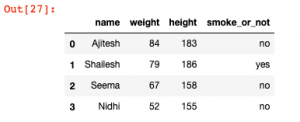
One of the most popular modules for working with data in Python is the Pandas library. Pandas provides data structures and operations for working with structured data. A key concept in Pandas is the Dataframe. Learning how to create and use dataframes is an important skill for anyone including data analysts and data scientists working with data in Python. In this post, you will learn about how to create a Pandas dataframe with some sample data. What is Pandas Dataframe? A Pandas dataframe is a two-dimensional data structure, like a table in a spreadsheet, with columns of data and rows of data. Dataframe is analogous to a table in SQL …
Statistics – Random Variables, Types & Python Examples
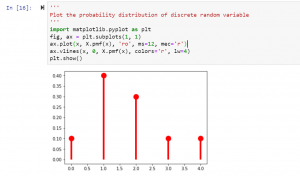
Random variables are one of the most important concepts in statistics. In this blog post, we will discuss what they are, their different types, and how they are related to the probability distribution. We will also provide examples so that you can better understand this concept. As a data scientist, it is of utmost importance that you have a strong understanding of random variables and how to work with them. What is a random variable and what are some examples? A random variable is a variable that can take on random values. The key difference between a variable and a random variable is that the value of the random variable …
Machine Learning Sklearn Pipeline – Python Example
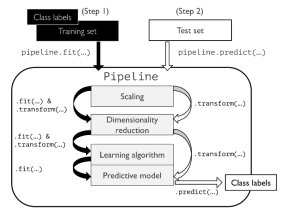
In this post, you will learning about concepts about machine learning (ML) pipeline and how to build ML pipeline using Python Sklearn Pipeline (sklearn.pipeline) package. Getting to know how to use Sklearn.pipeline effectively for training/testing machine learning models will help automate various different activities such as feature scaling, feature selection / extraction and training/testing the models. It is recommended for data scientists (Python) to get a good understanding of Sklearn.pipeline. Introduction to Machine Learning Pipeline & Sklearn.pipeline Machine Learning (ML) pipeline, theoretically, represents different steps including data transformation and prediction through which data passes. The outcome of the pipeline is the trained model which can be used for making the predictions. …
Sample Dataset for Regression & Classification: Python
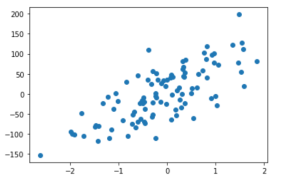
A lot of beginners in the field of data science / machine learning are intimidated by the prospect of doing data analysis and building regression (linear) & classification models in Python. But with an ability to create sample dataset using Python packages, you can practice your skills and build your confidence over a period of time. The technique demonstrated in this blog post to create and visualize / plot the sample dataset includes datasets that can be used for regression models such as linear regression and classification models such as logistic regression, random forest, SVM etc. You can use this technique to explore different methods for solving the same problem. …
Sklearn SimpleImputer Example – Impute Missing Data
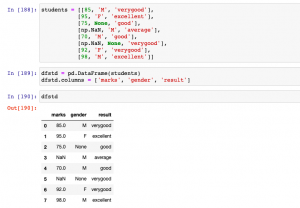
In this post, you will learn about how to use Python’s Sklearn SimpleImputer for imputing / replacing numerical & categorical missing data using different strategies. In one of the related article posted sometime back, the usage of fillna method of Pandas DataFrame is discussed. Handling missing values is key part of data preprocessing and hence, it is of utmost importance for data scientists / machine learning Engineers to learn different techniques in relation imputing / replacing numerical or categorical missing values with appropriate value based on appropriate strategies. SimpleImputer Python Code Example SimpleImputer is a class in the sklearn.impute module that can be used to replace missing values in a dataset, using a …
Pandas dropna: Drop Rows & Columns with Missing Values
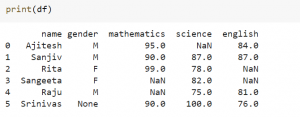
In this blog post, we will be discussing Pandas’ dropna method. This method is used for dropping rows and columns that have missing values. Pandas is a powerful data analysis library for Python, and the dropna function is one of its most useful features. As data scientists, it is important to be able to handle missing data, and Pandas’ dropna function makes this easy. Pandas dropna Method Pandas’ dropna function allows us to drop rows or columns with missing values in our dataframe. Find the documentation of Pandas dropna method on this page: pandas.DataFrame.dropna. The dropna method looks like the following: DataFrame.dropna(axis=0, how=’any’, thresh=None, subset=None, inplace=False) Given the above method and parameters, the following …
Perceptron Explained using Python Example
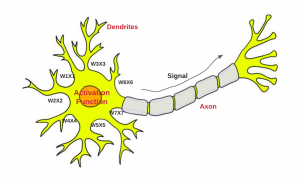
In this post, you will learn about the concepts of Perceptron with the help of Python example. It is very important for data scientists to understand the concepts related to Perceptron as a good understanding lays the foundation of learning advanced concepts of neural networks including deep neural networks (deep learning). What is Perceptron? Perceptron is a machine learning algorithm which mimics how a neuron in the brain works. It is also called as single layer neural network consisting of a single neuron. The output of this neural network is decided based on the outcome of just one activation function associated with the single neuron. In perceptron, the forward propagation of information happens. Deep …
Tensor Explained with Python Numpy Examples
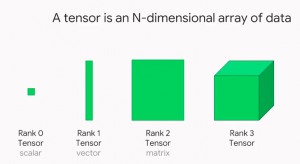
Tensors are a hot topic in the world of data science and machine learning. But what are tensors, and why are they so important? In this post, we will explain the concepts of Tensor using Python Numpy examples with the help of simple explanation. We will also discuss some of the ways that tensors can be used in data science and machine learning. When starting to learn deep learning, you must get a good understanding of the data structure namely tensor as it is used widely as the basic data structure in frameworks such as tensorflow, PyTorch, Keras etc. Stay tuned for more information on tensors! What are tensors, and why are …
Tensor Broadcasting Explained with Examples
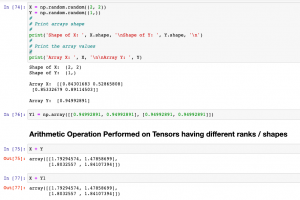
In this post, you will learn about the concepts of Tensor Broadcasting with the help of Python Numpy examples. Recall that Tensor is defined as the container of data (primarily numerical) most fundamental data structure used in Keras and Tensorflow. You may want to check out a related article on Tensor – Tensor explained with Python Numpy examples. Broadcasting of tensor is borrowed from Numpy broadcasting. Broadcasting is a technique used for performing arithmetic operations between Numpy arrays / Tensors having different shapes. In this technique, the following is done: As a first step, expand one or both arrays by copying elements appropriately so that after this transformation, the two tensors have the …
SVM Classifier using Sklearn: Code Examples
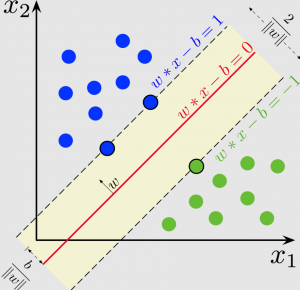
In this post, you will learn about how to train an SVM Classifier using Scikit Learn or SKLearn implementation with the help of code examples/samples. An SVM classifier, or support vector machine classifier, is a type of machine learning algorithm that can be used to analyze and classify data. A support vector machine is a supervised machine learning algorithm that can be used for both classification and regression tasks. The Support vector machine classifier works by finding the hyperplane that maximizes the margin between the two classes. The Support vector machine algorithm is also known as a max-margin classifier. Support vector machine is a powerful tool for machine learning and has been widely used …
Stochastic Gradient Descent Python Example
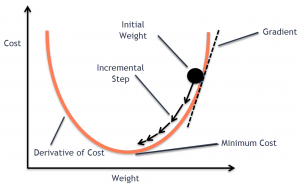
In this post, you will learn the concepts of Stochastic Gradient Descent (SGD) using a Python example. Stochastic gradient descent is an optimization algorithm that is used to optimize the cost function while training machine learning models. The most popular algorithm such as gradient descent takes a long time to converge for large datasets. This is where the variant of gradient descent such as stochastic gradient descent comes into the picture. In order to demonstrate Stochastic gradient descent concepts, the Perceptron machine learning algorithm is used. Recall that Perceptron is also called a single-layer neural network. Before getting into details, let’s quickly understand the concepts of Perceptron and the underlying learning …
Correlation Concepts, Matrix & Heatmap using Seaborn
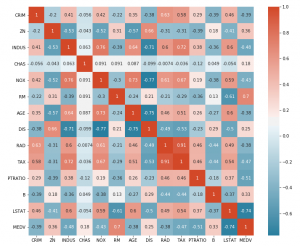
In this blog post, we’ll be discussing correlation concepts, matrix & heatmap using Seaborn. For those of you who aren’t familiar with Seaborn, it’s a library for data visualization in Python. So if you’re looking to up your data visualization game, stay tuned! We’ll start with the basics of correlation and move on to discuss how to create matrices and heatmaps with Seaborn. Let’s get started! Introduction to Correlation Correlation is a statistical measure that expresses the strength of the relationship between two variables. The two main types of correlation are positive and negative. Positive correlation occurs when two variables move in the same direction; as one increases, so do …
Python – Matplotlib Pyplot Plot Example
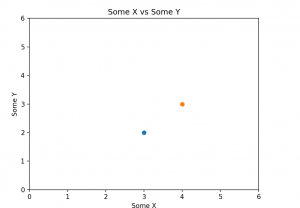
Matplotlib is a matlab-like plotting library for python. It can create both 2D and 3D plots, with the help of matplotlib pyplot. Matplotlib can be used in interactive environments such as IPython notebook, Matlab, octave, qt-console and wxpython terminal. Matplotlib has a modular architecture with each layer having its own dependencies which makes matplotlib very versatile and allows users to use only those modules they need for their applications. matplotlib provides many hooks that allow developers to customize matplotlib features as they need. Matplotlib architecture has a clear separation between user interface and drawing code which makes it easy to customize or create new interfaces for matplotlib. In this blog …
Elbow Method vs Silhouette Score – Which is Better?
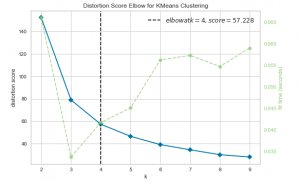
In K-means clustering, elbow method and silhouette analysis or score techniques are used to find the number of clusters in a dataset. The elbow method is used to find the “elbow” point, where adding additional data samples does not change cluster membership much. Silhouette score determines whether there are large gaps between each sample and all other samples within the same cluster or across different clusters. In this post, you will learn about these two different methods to use for finding optimal number of clusters in K-means clustering. Selecting optimal number of clusters is key to applying clustering algorithm to the dataset. As a data scientist, knowing these two techniques to find …
Hello World – Altair Python Install in Jupyter Notebook
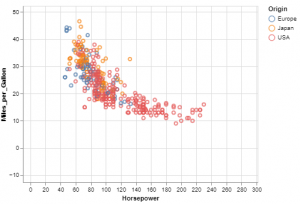
This blog post will walk you through the steps needed to install Altair graphical libraries in Jupyter Notebook. For data scientists, Altair visualization library can prove to very useful. In this blog, we’ll look at how to download and install Altair, as well as some examples of using Altair capabilities for data visualization. What is Altair? Altair is a free statistical visualization library that can be used with python (2 or 3). It provides high-quality interactive graphics via an integrated plotting function ́plot() that produces publication-quality figures in a variety of hardcopy formats and interactive environments across platforms. Altair is also easy to learn, with intuitive commands like ‘plot’, ‘hist’ …
Free Python & R Training from Spoken Tutorial Initiative

Many people today are interested in learning Python and R. Are you starting on data science and machine learning and looking to get trained with python and R skills? These two programming languages are very popular because they allow for the analysis of data sets that is not possible with other tools. The training offered at Spoken Tutorial Initiative will introduce you to Python and R, while also providing helpful tips on how to use them effectively. Spoken Tutorials Initiative by IIT Bombay is an initiative of NME (National mission on Education) through Govt. of India, ICT, MoE to promote IT literacy on free and open source software (FOSS) by …
I found it very helpful. However the differences are not too understandable for me